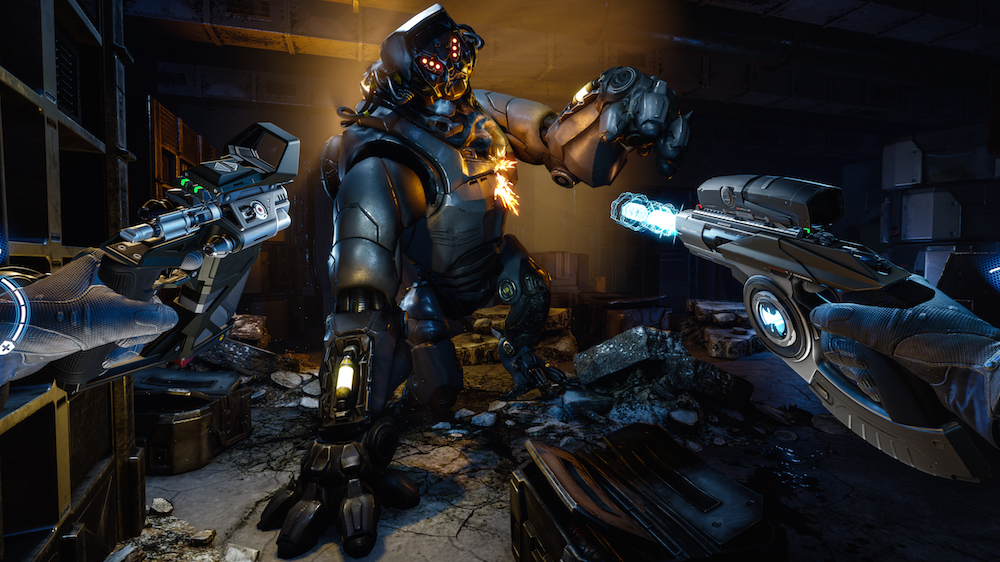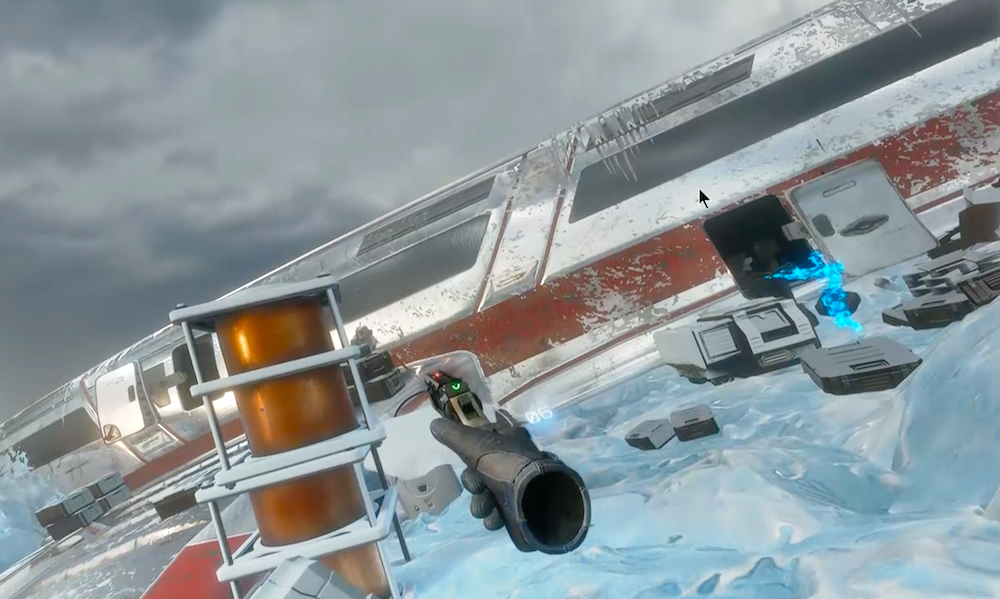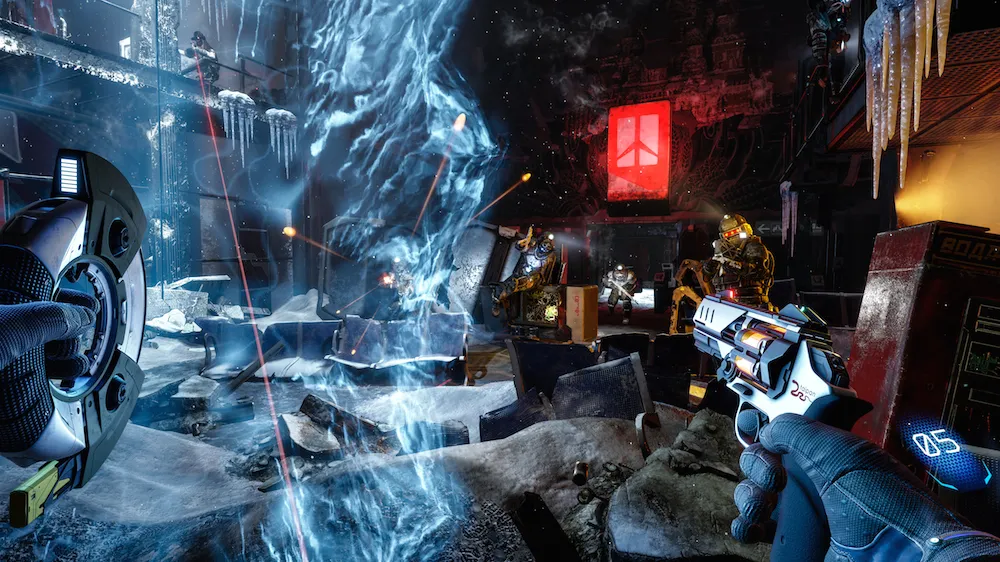4A Games’ first VR game, Arktika.1, isn’t a spin-off of its popular Metro series but, honestly, it might as well have been. It’s a post-apocalyptic first-person shooter (FPS) set in Russian wastelands in which you scurry around darkened hallways, trading shots with armies of faceless Russian goons and fending off the occasional monster. If you’ve played any of the entries in the developer’s flagship series, that will sound more than a little familiar.
Perhaps it’s best that 4A sticks to what it knows for its Oculus Rift debut, though. On paper, the team created something many of us have been crying out for; a shooter that lasts longer than two hours in which you don’t stand in the same room fighting off waves of enemies but instead progress through a tightly-designed world. Ironically, though, in bringing the VR shooter that much closer to the more traditional console and PC experience, some of the genre’s tropes and issues manage to wriggle their way in too.
Arktika’s snowy wastes make for an interesting setting, though sadly much of what you’ll find out about the world is through exposition. At the start of the game your companion, Victoria, drives you through the human settlement camp that has hired your mercenary skills for protection. Once you get to your base of operations, though, you won’t see or hear from any other friendly humans for the entire game. It would be great to get a sense of what you’re fighting for and maybe even grow a connection with your fellow humans but you’re essentially confined to a shooting range and a mission selection screen in your downtime.
Instead, the game is far more concerned with the core action. In fact, Arktika is a bit of a gun nut; its highly-detailed arsenal of fantastical pistols is the star of the show, offering everything from single-shot Magnums that are deeply satisfying to fire off to more experimental lasers and handheld shotguns that vary wildly in accuracy and damage.
You take these death machines into battles that are largely cover-based, demanding you find a safe spot behind some rubble or other obstacles and then pop out for a few shots at the enemy before leaning back in, reloading and preparing to do it all over again. Arktika’s high production values and finely-tuned handling can make these encounters a real thrill; I loved having to throw myself behind car doors and under crates as gunfire rattled off from all sides, emerging seconds later to unleash my own deafening attack. Physically shifting my body into cover rooted me in the experience, though it’s slightly at odds with the larger movement mechanics.
Arktika uses a node-based teleportation system, meaning you can only move to specific points in the world and there’s very little chance for exploration. It’s fair to say the system is somewhat dated given that most other VR games will allow free teleportation at the very least, but it’s not a completely lost cause.

At its best, the teleportation mechanic is complemented by the game’s level design. In larger areas you’ll be given the option to move between three or four spaces, and an indicator will tell you if your next move offers good cover or sacrifices safety for better vantage points. It adds just a touch of strategy to the shooting; you’ll probably want to hunker down and take pot shots when enemies flood in, but you can quickly finish off any stragglers by flanking them to more open cover and firing fast.
On the flipside, there are often times that it’s difficult to get a beat on the enemy with the limited teleportation options, and you’ll find yourself longing to be able to take a few virtual steps to the left or right to get a slightly better angle.
Movement issues aside, Arktika’s early levels set the stage for an exciting few hours of action quite nicely, but the game struggles to keep this momentum going over the five to six-hour campaign.
The monsters, for example, at first promise to change up the pace of the combat, but are strangely underutilized. Your first encounter with them is a frighteningly brutal affair, as you fend off several on an elevator ride that just won’t seem to end. They channel the chills of Resident Evil 7’s horrifying leech monsters, so much so I was even concerned it might be a little too much terror for my tastes. But you’ll only see them a handful more times throughout the campaign and never in large packs, as if 4A never really figured out what to do with them past that initial sequence. They’re even central to the late-game plot, which makes their absence from combat all the more confusing.

As such, the more of Arktika’s traditional firefights I encountered, the gradually less exciting they became, especially when later levels reuse some of the older environments. The game also gets significantly easier as you upgrade your weapons and buy new ones. Money comes in abundance, meaning you can purchase pretty much any gun you want by the end of the second level. I picked up a pistol that continuously spurted a laser beam, but it made the action so easy I reverted back to traditional weapons to inject some life back into the experience.
Outside of the combat, 4A introduces regular roadblocks with light puzzling, ranging from the utterly pointless (finding door codes waiting in plain sight) to the mildly entertaining (rerouting power on circuit boards). The team does a better job of putting twists on the action itself; taking cover in crates as you ride along conveyor belts provides on-rails shootouts.
For better and worse, it is very much a case of applying classic game design rules to the VR shooter. True, it gives fans what they’ve been asking for, but little of what’s here really feels like an expression of what VR is truly capable of. My most memorable moment was completely unintentional, in which I kept a gun trained on an NPC I didn’t trust as he handed me my objective. Outside of this, the game largely covers the same ground titles like Robo Recall already explored.
Arktika.1 is caught between a rock and a hard place. On the one hand, it’s an extremely polished shooter with a longer-than-average campaign (for VR) and a structure closer to more traditional entries into the genre rather than the many wave-based alternatives available on headsets. On the other, its repetitive missions, unbalanced weapons and upgrade system and limited locomotion eventually took their toll, resulting in initially exciting levels with diminishing returns. The search for VR’s shooter king continues.
Arktika.1 is available now on the Oculus Rift for $29.99. Read our Game Review Guidelines for more information on how we arrived at this score.


























